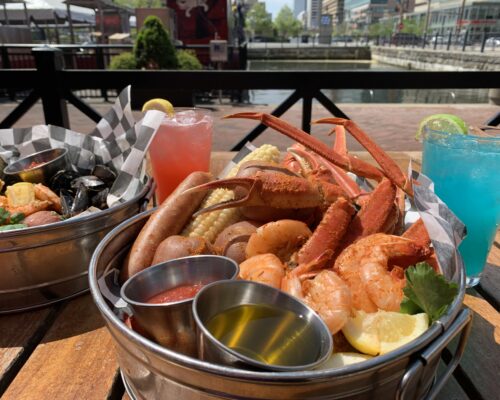These are the deep-blue days of summer.
It’s no secret, especially to those who follow my writing, that when it comes to fishing, I’m about as much of a generalist as you can get. I’ve tossed flies for brown trout, chunked for cobias, jigged for rockfish and stalked skinny waters for trout, all at competent levels, yet always shy of expert.
I’ve also fished offshore but you’ll never mistake me for one of those salty characters on Wicked Tuna. My pockets are too shallow, attention span too short.
Still, the open Atlantic remains an endless source of fascination for me. For eons it has drawn in seafarers with the pull of Jupiter in the pursuit of wealth—seafood, treasure, or new lands to claim. In recent times, the sporting types seem just as captivated by different rewards, chiefly catching big, tough gamefish on hook and line from small vessels.
As you read this, the mid-Atlantic’s summer offshore season is in high gear. Impressive catches of tunas have hit the docks. Blue and white marlins have been caught, with most swimming away after release, especially during the blue-water tournaments.
When the ocean is in a particularly good mood, the small-boat fleet can also get in on the action. They sail from inlets such as Rudee, Wachapreague, Chincoteague, Ocean City or Indian River, sometimes in crafts that barely measure 24 feet, trailing the larger sport fishers like little brothers refusing to stay home on the porch.
In years past, I played that game, chasing pelagics aboard Voodoo Cat, my 20-foot power catamaran rigged with twin four-stroke engines, which, back then, were new on the scene. I fished near shore lumps like the Jackspot off Ocean City. I was told these were good beginner spots, where I could acquire the necessary skills without going bankrupt on fuel and gear, and more importantly, near enough to allow a dash back inshore should the sea turn snotty.
For my first offshore trip on that small boat, I convinced a friend to venture from Wachapreague to 26-Mile Hill, a small seamount that rises 30-plus feet from the seafloor, and can attract tunas, mackerels and dolphinfish (mahi). It was so calm we could’ve been fooled into believing we could reach Galway with little trouble.
We stumbled upon a weed line formed by the winds and currents, which can often hold fish. After a few passes trolling feathered cedar plugs we decked a couple small “peanut” dolphin, my first blue water conquests. I was ecstatic. Mahis are magical fish with dark spots set upon resplendent backdrops of light gold, and cosmically vibrant greens and blues finishing off their brilliant palette. However, once out of the sea—poof!—their colors fade forever.
The most memorable trip aboard that boat occurred many moons ago, with a different friend. I’ll leave his name out, because he still fishes regularly out of Ocean City. On most things, he’s much wiser than I am, and today his craft was a 41-footer with twin inboard diesel motors.
Once clear of the rock jetties lining Ocean City Inlet, million-dollar sportfishing boats blasted past us like Usain Bolt through a crowd of mall-walkers. Those lean, fish-fighting machines carved a path we could not follow out to the fishing grounds, their diesel engines growling in annoyance as they left us in their wake. Some 35 miles off the beach, we set anchor at the Hambone, and ladled chunks of butterfish and bunker into the sea. Not knowing what else to do, we discussed strategy. Who’d fight the first fish? Would we kill it or release it? Keep the fighting belt handy! Confidence and blissful ignorance sometimes look the same.
Amidst this conjecture, the line suddenly screamed off the port reel. My compadre yanked the rod from the holder, and, as Sherlock would say, the game was afoot. But what game? Tuna? If so what kind? Perhaps a gaffer dolphin, or was it a wahoo or kingfish that was punishing the reel’s drag? Monofilament evaporated from the reel for what seemed like hours.
Eventually the angler regained line and control, but that was short-lived. Whatever tribe that fish hailed from, it had no intention of surrendering peacefully. Ten minutes turned into twenty, and it finally broke the surface to reveal its signature dorsal fin. A shark! Then, without warning, as if putting us on notice, it demonstrated its raw power by screaming across the bow and exploding out of the water like a Tomahawk missile.
The two-legged competitor settled in for another round, and it was a bar-room brawl as we scrambled to keep up with the fish’s merciless runs. It circled the boat three times, forcing us to bring the rod over, under, then back over the anchor line. Two more acrobatic jumps took the fish completely out of the water in angry protest at our audacity to think it could be tamed. That exhibition alone made the bumpy ride out worthwhile.
After nearly an hour, he finally brought the fish alongside. It was a shortfin Mako shark, nearly seven feet long and easily close to 100 pounds, though even today in my mind’s eye it remains the stuff found in Russell Drumm’s landmark book, In the Slick of the Cricket (highly recommended). We had no means of properly dispatching it, of course, but at least we had enough common sense not to ask that angry beast to join us inside our small boat.
As the shark drifted gently beside us, momentarily whipped from battle, I stared deep into its coal black eye, sizing up this magnificent, wild creature. Time slowed down, like chilled molasses. It was surreal, the shark’s streamlined body a deep grayish blue that gave way to white sides. It was intoxicating to be so close to one of the ocean’s top predators. We cut the line and let it go.
My blue water exploits pale by comparison to many others. Sometimes just a taste is all you
need. I’ve been fortunate to deck a 138-pound bigeye tuna—at night, no less—that whipped me but good. For more than an hour I fought a yellowfin tuna, estimated to be 150 pounds or so, to within gaffing range only to hear that awful ping, the most demoralizing sound. Stunned and spent, all I could spit out was “No Más,” like Roberto Durán after Sugar Ray Leonard was done with him.
If you’ve ever tangled with a large tuna, particularly a yellowfin or bluefin, then you know it’s a bar-room brawl. I wrestled a bit in junior high and high school, but I never took a whupping like the one that tuna put on me. I was sore for days in places I forgot I had muscles.
I share these remembrances not to brag but to convey that if I can do it, so can you. And you ought to, as long as you “take care of the knowns,” per the sports cliché. Ensure the skipper, boat, and gear are in sound working order and up to the task; pick a calm weather window; file a float plan; and, if possible, travel in tandem with another boat.
Or, go with the pros. A professional captain and mate take much of the guess-work out of things, and accelerate the learning curve. Trust me, there’s a lot to learn. True, offshore fishing trips aren’t cheap, but if you go with friends and family, not only is it affordable, you’re likely to have more fun. That’s what sport fishing is all about, right?




